Nissan Versa Spark Plugs
Replacement Guide
How to change the spark plugs in a 2nd
generation 2012 to 2019 Nissan Versa with the HR16DE 1.6L I4 engine.
By Paul B. Michaels Author & Photographer Auto Mechanic Since 1989 |
||
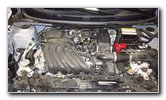 2019 Versa SV 1.6L I4 |
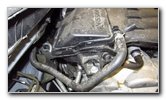 Left Side Intake Manifold |
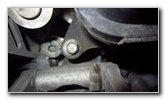 Intake Manifold Bolt |
| This automotive
maintenance tutorial was specifically written to assist owners of the second
generation 2012, 2013, 2014, 2015, 2016, 2017, 2018 and 2019 Nissan Versa
sedan in checking or changing the spark plugs in the HR16DE 1.6 liter inline
four cylinder engine. Owners of other Nissan vehicle such as the Sentra, Altima, Maxima, Murano, Rogue, Note, Leaf, Juke, Kicks, Latio, Almera, Sunny, Qashqai, NV200, Pathfinder, Frontier and X-Trail may also find these DIY instructions to be helpful. The OEM (original equipment manufacturer) platinum tipped spark plugs in this 2019 Nissan Versa SV with the HR16DE 1.6L I4 engine were part number NGK PLZKAR6A-11 (5118). Please verify the correct part number for your vehicle before purchasing new spark plugs. The tools and other items needed to complete this procedure include a 14mm spark plug socket, an extension bar, a 3/8" drive ratchet, a standard flat head screwdriver, needle nose pliers, a 10mm socket with an extension bar, a 1/4" drive ratchet and a tube of dielectric grease. An optional item is anti-seize lubricant. Most spark plug manufacturers recommend that you do NOT use anti-seize since it can easily lead to over tightening. Since this 2019 Versa only has about 15,000 miles on the odometer, I'll just be checking and replacing the one exposed spark plug on the right (driver) side of the engine. I've included written instructions for removing the intake manifold in order to access all four spark plugs. |
||
|
|
||
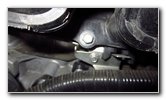 |
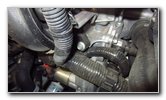 |
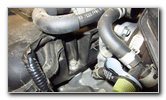 |
| To access the other
three spark plugs, you will need to detach the black plastic intake manifold
from the top of the engine which requires quite a few steps. Just take your
time and be gentle.
Make sure the engine is completely cool or cold before continuing. Do not attempt this procedure on a hot engine! In order to remove the intake manifold, you'll have to loosen the hose clamp that attaches the large rubber air intake hose from the engine air filter box to the throttle body by turning it in the counterclockwise direction with the flat head screwdriver or an 8mm socket with a 1/4" drive ratchet. Pull large rubber hose off the throttle body. Disconnect the air vacuum hoses from the intake manifold including the PCV valve hose on the left (passenger) side and the one attached to the engine air filter housing on the right. There are two hoses on the left (passenger) side. You'll need to use pliers to squeeze together the two tabs on the metal hose clamp before sliding it away from the nipple on the intake manifold before pulling the rubber hose straight off. To disconnect the wire loom from the intake manifold, pinch together the two tabs or "prongs" on the black plastic retaining clip before sliding it straight out of the hole. Disconnect the electrical connectors on the throttle body. Remove the 10mm bolt on the left (passenger) side by the rear corner of the intake manifold (mounted vertically - up and down). Remove the 10mm bolt on the right (driver) side by the rear corner of the intake manifold by the throttle body (mounted vertically - up and down). Remove the five 10mm bolts on the front edge of the intake manifold (close to the front of the car) by turning them in the counterclockwise direction. The front five bolts are mounted horizontally (front of the car to the rear of the car). Carefully remove the two coolant hoses near the bottom of the throttle body. A small amount of coolant may leak out. Try to keep the ends of the hoses pointing up. Remove the dipstick for more clearance and set it aside in a safe place. Carefully lift the intake manifold assembly off the top of the engine and set it aside in a safe place. |
||
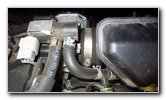 Throttle Body Hose Clamp |
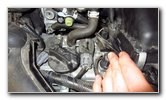 Driver Side Ignition Coil |
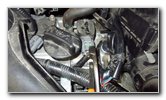 Squeeze Release Tab |
| Once you have the
intake manifold removed, you can begin checking or changing the four spark
plugs. To help prevent from having debris or foreign objects fall down into the spark plug well or cylinder, I recommend only checking or changing one spark plug at a time. Push down the release tab on the electrical connector before sliding it straight off the ignition coil. I had trouble pushing down the release button, so I used some pliers to squeeze the release tab. |
||
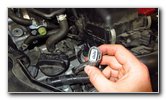 Disconnect Power Plug |
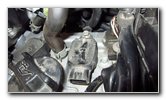 Ignition Coil |
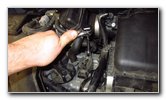 Loosen Counterclockwise |
| Loosen the single bolt that secures the ignition coil in place by turning it in the counterclockwise direction with a 10mm socket and a 1/4" drive ratchet. | ||
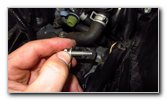 Spin Out Ignition Coil Bolt |
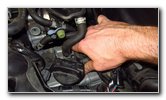 Rotate Back & Forth |
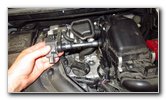 Lift Out Ignition Coil |
| Spin out the bolt
the last few turns by hand to help prevent it from falling down and becoming
lost in the engine bay. Set the bolt aside in a safe place. Gently rotate the ignition coil back and forth a few times to help make sure the rubber dust boot at the bottom isn't stuck or "frozen" to the top of the old spark plug. Lift the ignition coil straight out of the spark plug well. |
||
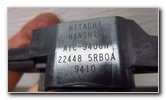 OEM Part Number |
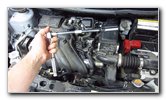 Socket & Extension Bars |
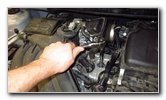 Loosen Counterclockwise |
| If there is a CEL
(check engine light) or SES (service engine soon) warning light on your
gauge cluster, use an OBDII scanner
(also known as an "OBD2 scan tool") to check for an ignition coil related
DTC (diagnostic trouble code) such as P0350, P0351, P0352, P0353 and P0354. The OEM ignition coils are marked as part number Hitachi Hanshin AIC-9408N 22448 5RBOA 9410. A compatible replacement set of aftermarket ignition coils are part number TRQ ICA64416. Attach the 14mm spark plug socket to the long extension bar (or two short extension bars) and the 3/8" drive ratchet. (A 9/16" spark plug socket would also work if that's all you have available.) Lower the socket over the top of the old spark plug. Loosen the old spark plug by turning it in the counterclockwise direction. If you have trouble loosening the old spark plug due to corrosion (rust) or debris, try spraying a very small amount of penetrating oil down into the spark plug and wait ten to fifteen minutes. |
||
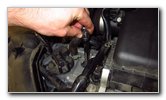 Spin Out Old Spark Plug |
 Old Spark Plug Removed |
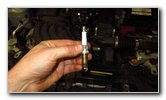 Inspect Old Spark Plug |
| Once the old spark
plug is loose, detach the ratchet and spin it out the rest of the way by
turning the extension bar with your fingers. Carefully lift the old spark plug out of the well and detach it from the socket. Inspect the old spark plug for any signs of damage or excessive wear. If the old plug appears to be burnt or covered in soot and oily sludge, the engine may be burning oil and should be inspected by a professional mechanic. If the electrode tip on appears to be burnt or covered in white powder, the engine might have been subjected to overheating and you may need to choose a spark plug with a different heat range (colder or hotter) for your climate. |
||
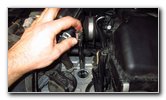 Spin In New Spark Plug |
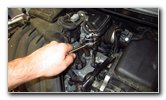 Tighten Clockwise |
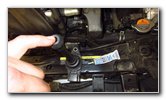 Apply Dielectric Grease |
| If you have a
spark plug gap gauge tool, check
the gap on the new spark plugs.
The OEM NGK PLZKAR6A-11 (5118) spark plugs should have a gap of .043" (1.1mm) according to the manufacturer and the shop manual. Push the new spark plug into your socket. Your socket should have a rubber insert or a strong magnet to securely hold the spark plug in place. Carefully lower the new plug down into the well. Try to avoid hitting the electrode tip against the sides of the well or the top of the cylinder head. Spin in the new spark plug in the clockwise direction until it makes contact with the cylinder head. If you are installing a new spark plug, continue tightening it in the clockwise direction with the 3/8" drive ratchet to just past the point when you feel the new crush washer collapse. This should be about 3/8 to 1/2 turn past when the spark plug first makes contact with the cylinder head. If you have a very sensitive and reliable torque wrench, the service manual for the 2017 Nissan Versa lists a torque specification of 14 lb-ft or 19.6 N-m for tightening the spark plugs. I recommend that you do NOT use anti-seize lubricant grease since it can easily lead to over tightening. If you are just re-installing the old spark plug after checking it, you will only need to tighten it a small fraction of a turn past finger tight until it is snug. Avoid over tightening the spark plugs to prevent from cracking the ceramic or damaging the aluminum threads. Apply a small amount of dielectric grease to the opening in the rubber dust boot at the bottom of the ignition coil. The dielectric grease will help keep out any moisture, dust or debris and ensure a reliable electrical connection. |
||
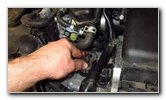 Lower In Ignition Coil |
 Spin In 10mm Bolt |
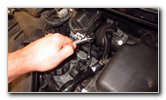 Tighten Bolt Clockwise |
| Lower the ignition
coil down into the well and secure the rubber dust boot to the top of the
new spark plug. Line up the bolt hole in the ignition coil with the corresponding bolt hole in the valve cover. Spin in the 10mm bolt a few turns by hand to help prevent it from becoming cross threaded. Tighten the bolt in the clockwise direction with the 10mm socket and a 1/4" drive ratchet until it is snug. The torque specification in the 2017 Nissan Versa service manual for tightening the 10mm ignition coil bolt is just 62 in-lb or 7 N-m. Try to avoid over tightening the bolt to prevent from cracking the plastic housing. |
||
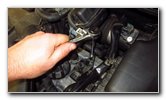 Ignition Coil Secured |
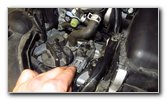 Push On Power Plug |
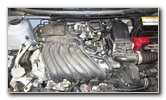 New Spark Plug Installed |
| Slide the
electrical connector straight on to the ignition coil. You should feel or hear the power plug "click" securely into place. Double check that the bolts and electrical connectors are securely attached. Replace the intake manifold, re-attach the throttle body hoses and connect the power plugs. Double check that every rubber hose is securely re-attached and every electrical connector has been replaced. Be sure to write down the spark plug change in your car's service records. The service interval specification in the owner's manual is to change the platinum tipped spark plugs at least every 105,000 miles or every 168,000 km. Please
check out all of my
2012-2019 Nissan Versa DIY Repair & Maintenance Guides. |
||
| If you found this guide to be helpful,
please consider making a small donation by clicking on the PayPal.com
"Donate" button located to the right of this paragraph. Thank you!
(Note: I am not a registered charity. Donations are not tax deductible.) |

